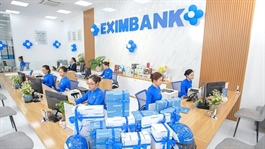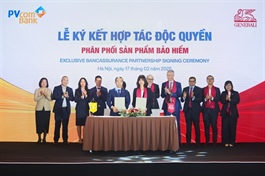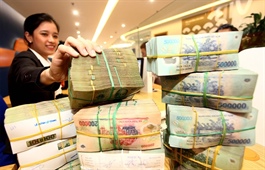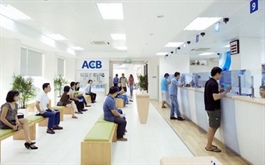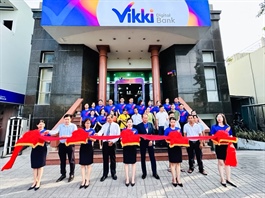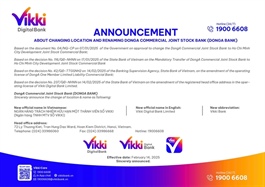Lenders use Lunar New Year to offer alluring rates
Lenders use Lunar New Year to offer alluring rates
Following the Lunar New Year holiday, many banks simultaneously adjusted deposit interest rates to attract idle capital from customers, while lending rates also showed an upward trend, presenting attractive opportunities, but also significant challenges for borrowers.
Immediately after the holiday break, numerous banks adjusted their interest rates with significant increases, particularly for medium- and long-term deposits.
Among them, PVcomBank currently leads the market with an interest rate of 9 per cent per annum for 12-month deposits. However, this rate is not available to all customers but applies only to deposits of at least $84,000 made at the counter and may come with certain preferential conditions.
Other banks are also joining the race to offer attractive interest rates to attract deposits post-holiday. MSB currently lists the highest 6.3 per cent annual rate for 12-month deposits. For longer-term, Eximbank leads with a 6.5 per cent rate for 18-month deposits, followed by BVBank with a 6.35 per cent rate, and BAC A BANK, Bao Viet Bank, and Saigon Bank all offering 6 per cent per annum.
While private and smaller banks are aggressively raising deposit rates to attract capital, the four biggest state-owned commercial banks, Vietcombank, BIDV, Agribank, and VietinBank, maintain lower rates at 4.7 per cent for long-term deposits, leveraging their abundant liquidity and stable funding sources.
According to the January macroeconomic outlook report by MB Securities, the ongoing recovery in manufacturing and the acceleration of public investment disbursement are putting pressure on deposit rates. Banks require ample capital to meet credit demand, particularly in priority sectors.
“The likelihood of policy rate cuts in 2025 is low. Credit growth trends, liquidity pressures, and the need to manage exchange rates may keep deposit rates elevated. This implies that borrowing costs will not decline rapidly, requiring businesses and borrowers to carefully plan their financial strategies this year,” the report stated.
“In general, the early 2025 interest rate hikes not only reflect banks’ capital mobilisation strategies but also signal liquidity pressures and monetary policy expectations in the near future.”
The Q1 business sentiment survey published by the Forecast and Statistics Department of the State Bank of Vietnam (SBV), released in early January, indicates that credit institutions may slightly raise deposit and lending rates by 0.2-0.3 percentage points.
“This move aims to ensure sufficient capital to meet credit growth targets and manage exchange rates amid closely monitored inflation conditions,” it said.
A noteworthy development in this adjustment cycle is the participation of several foreign banks in the interest rate race.
Woori Bank, an active foreign player in Vietnam, has introduced a special deposit rate of up to 11 per cent per annum for specific savings programmes, albeit with conditions such as a maximum monthly deposit of $83 and mandatory digital banking usage.
Meanwhile, foreign banks such as Standard Chartered, HSBC, and Shinhan Bank continue to maintain stable rates, focusing on corporate clients rather than competing directly with domestic banks.
ACBS Securities forecasts a divergence in deposit rate trends among banks. State-owned commercial banks are expected to maintain stable deposit rates to support economic growth. “Private commercial banks, however, may slightly increase deposit rates to strengthen capital mobilisation for credit expansion,” it said.
Contrary to the typical post-Tet surge in deposit rates, when individuals tend to save more after a year of work, on February 3, the first working day of the Lunar New Year, Techcombank was the only bank to adjust its deposit rates downward, reducing short-term deposit rates by 0.2 percentage points to 3.15-3.55 per cent per annum.
However, the bank swiftly reversed its decision and raised deposit rates again just two days later. A move seen as contrary to market trends, as Techcombank initially cut rates when liquidity was at its peak, but promptly changed course to align with the banking industry trend.
For 2025, Techcombank predicts that a strong USD will push the exchange rate up by 2.5-3 per cent this year. “Lending rates are expected to rise slightly by 0.2-0.25 percentage points,” the bank said.
Vietcombank Securities also anticipates lending rates to increase by 0.5-0.7 percentage points amid strong credit demand and economic recovery.
Dr. Nguyen Tri Hieu, director of the Institute for Research and Development of Global Financial and Real Estate Markets, said that from a risk perspective, bank deposits remain the safest investment channel. “Currently, all banks are under the SBV’s protection, including weaker ones. This has been evident in cases such as OceanBank and Construction Bank, which were merged into stronger banks under the central bank’s mandatory transfer programme,” he said.
“At the start of the year, banks require substantial capital to execute their credit plans. The SBV’s expansion of credit limits to boost lending also compels banks to increase deposit mobilisation to maintain liquidity balance,” he added.
Not only are deposit rates rising, but lending rates are also trending upward, adding pressure on businesses and individual borrowers. Currently, average lending rates have increased by 0.3-0.7 percentage points compared to pre-Lunar New Year levels, reflecting tightened credit conditions and rising capital costs.





